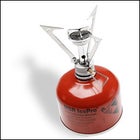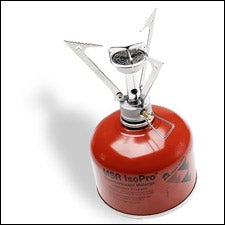Some of what your friend says is true. Sort of. As a general rule of thumb, stoves that use butane/propane canisters weigh less than gas stoves. Theyre simpler in construction and dont need the fuel lines, pumps, and so on. For instance, MSRs long-popular WhisperLite Shaker stove ($70; msrcorp.com), a white-gas model, weighs 13.12 ounces without the fuel bottle. That same companys canister-fueled Pocket Rocket ($40) weighs a mere 3.2 ounces.
MSR Pocket Rocket
 The MSR Pocket Rocket
The MSR Pocket RocketFor short trips, if you toss in a single fuel canister then youre setup in almost all cases will be lighter than carrying a liquid fuel stove, the fuel bottle, and fuel. It gets a little more complicated on longer trips, however. The Pocket Rocket boils slightly less water per eight ounces of fuel than the WhisperLite. So for long trips the WhisperLite will, eventually, be the lighter stove. I cant say what that point would beit depends on your cooking habits and whether you need to melt snow, that sort of thing. I also think that canister-fuel stoves incur a slight penalty because you cant fine-tune your fuel load. You can take one canister, or two or three, etc. With white gas you can be more precise and measure the fuel out by the fluid ounce.
As for me, Id say that trips of fives days or fewer would be lighter with canister stoves. More than that, Id take liquid fuel. A hyper-efficient stove such as the Jetboil Personal Cooking System ($90; jetboil.com) would extend that trade-off point by another five days. Its downside is that its a boiling-only stove, with no real cooking” possible. Although, they did recently release a fry-pan attachment ($50) to combat this issue.
Reliability advantages? Yeah, Im willing to believe that canister stoves are more reliable. They have fewer moving parts, no pumps that can break, and better quality control in the fuel. Do they burn hotter at altitude? Absolutely not. Canister stoves are MUCH improved in this arena in the past decade, but for very cold weather (below 10F) and when above 10,000 feet or so, I think liquid-fuel stoves remain the clear choice.
So there you go. Such is lifeno clear-cut answers.


